Management of the Frail Elderly With Breast Cancer
By the year 2030 most patients with breast cancer will be aged 65 years or more and many will be frail. Frailty implies diminished physiologic reserve; contributors include diminished organ function, comorbidities, impaired physical function, and geriatric syndromes. Time-efficient tools for assessing frailty are being developed and, once validated, can be used to identify frail cancer patients and help direct therapy. Screening mammography in frail patients is questionable, and a clinical breast exam is likely to identify breast cancers that warrant intervention. Hormonal therapy may be a reasonable primary therapy in older frail women with hormone receptor–positive lesions. For estrogen receptor– and progesterone receptor–negative lesions, excision of the primary tumor may be adequate. Adjuvant hormonal therapy may be appropriate in frail elders with high-risk hormone receptor–positive breast cancer; chemotherapy is rarely indicated regardless of tumor status. The majority of frail elders with metastases will have hormone receptor–positive breast cancers, and endocrine therapy should be considered; those with receptor-negative tumors may be treated with single-agent chemotherapy or supportive care measures. Oncologists need to acquire the skills to appropriately identify frail elders so they select appropriate therapies that will minimize toxicity and maintain quality of life.
By the year 2030 most patients with breast cancer will be aged 65 years or more and many will be frail. Frailty implies diminished physiologic reserve; contributors include diminished organ function, comorbidities, impaired physical function, and geriatric syndromes. Time-efficient tools for assessing frailty are being developed and, once validated, can be used to identify frail cancer patients and help direct therapy. Screening mammography in frail patients is questionable, and a clinical breast exam is likely to identify breast cancers that warrant intervention. Hormonal therapy may be a reasonable primary therapy in older frail women with hormone receptor–positive lesions. For estrogen receptor– and progesterone receptor–negative lesions, excision of the primary tumor may be adequate. Adjuvant hormonal therapy may be appropriate in frail elders with high-risk hormone receptor–positive breast cancer; chemotherapy is rarely indicated regardless of tumor status. The majority of frail elders with metastases will have hormone receptor–positive breast cancers, and endocrine therapy should be considered; those with receptor-negative tumors may be treated with single-agent chemotherapy or supportive care measures. Oncologists need to acquire the skills to appropriately identify frail elders so they select appropriate therapies that will minimize toxicity and maintain quality of life.
Cancer is the second leading cause of death in the United States, and the incidence of cancer increases with increasing age. From 1980 to 2003, the proportion of cancer deaths has increased, while deaths from heart disease and stroke has trended down, reflecting our aging population. In addition, data from the National Cancer Institute's Surveillance, Epidemiology, and End Results (SEER) program from 1998 to 2002 indicate that 56% of newly diagnosed cancer patients and 71% of cancer deaths occur in individuals greater than age 65.[1] The number of older adults with a cancer diagnosis will continue to increase as the population ages and life expectancies increase. In the United States, it is estimated that by 2030 70% of cancer patients will be over the age of 65.[2]
Breast cancer is a disease of aging, and its incidence increases with age (Figure 1). Approximately 1 in 125 women between the ages of 65 and 85 will develop breast cancer each year, as compared to 1 out of 390 women between the ages if 45 and 55.[3] Given the increasing incidence of breast cancer with age and an increasing proportion of the US population over age 65, oncologists will be caring for an ever-larger number of elderly patients.
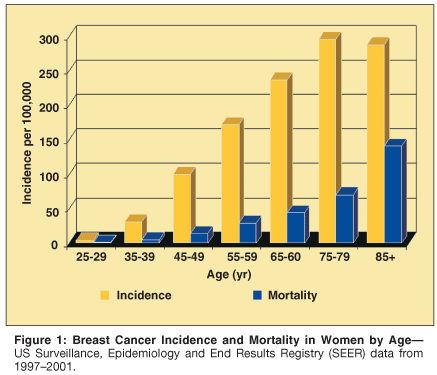
Breast cancer mortality also increases with increasing age (Figure 1).[4] However, SEER data suggest that stage at diagnosis is higher only for patients over age 85.[5] Clearly, other factors play a role in the increased breast cancer mortality with aging. Possible explanations include lower rates of screening mammography, less aggressive therapy after diagnosis, and the presence of comorbidity and frailty among older women.[6]
As the proportion of adults over 65 increases, a growing number of frail elders will develop breast cancer. Oncology interventions for frail elders with breast cancer pose a particular challenge, as non–breast cancer-related illnesses are likely to be the major causes of mortality, minimizing the potential benefits of breast cancer therapy. The attendant toxicity of therapy must be carefully considered. This review will examine domains of frailty and explore assessment tools to help identify patients at risk of negative outcomes with breast cancer therapy. Appropriate therapeutic interventions for frail breast cancer patients and possible interventions to prevent progression to frailty will also be discussed.
Characteristics of Frailty
Frailty has no standardized definition, although as health-care professionals we may feel we can intuitively recognize frail patients. The American Geriatric Society has defined frailty as a "physiological syndrome, characterized by decreased reserve and diminished resistance to stressors, resulting from cumulative decline across multiple physiological systems, and causing vulnerability to adverse outcomes."[7] Disease, inactivity, and physiologic changes with aging exhaust the inherent redundancy of muscular and neurologic backup systems and prevent a frail person from compensating in times of stress.[8]
Frailty is a chronic condition, although an acute event such as stroke can contribute to its severity. Adverse outcomes from frailty include falls, injuries, susceptibility to illness, dependence, and institutionalization. Frailty increases the risk of death.[8] Several factors contribute to frailty, including physiologic changes related to aging, chronic disease, decreased physical strength, and low levels of physical activity.[9,10]
Frailty can be independent of age or comorbidity.[10,11] Older adults show wide variations in physical function and disease, and chronologic age alone is an inadequate indicator of frailty. However, frailty is more common with increasing age, and the American Medical Association estimates that 40% of adults over age 80 are frail.[12] Many clinicians consider individuals over 85 as inherently frail due to the physiologic changes that occur with aging.[13,14] Others consider age over 70 to be a trigger to further investigate for the presence of frailty.[15]
Although the aging process is heterogeneous, universal physiologic changes described in Table 1 occur and can lead in time to decreased physiologic reserve in cardiac, respiratory, and renal function.[16] Several neurologic changes also occur with aging, including decreased vision and neuropathy. Decrease in hematopoietic reserve and impaired immunosurveillance with aging may also influence tolerance of systemic cancer therapy. As a whole, these changes contribute to an increased risk for chemotherapy-associated side effects and death in older patients.[17,18]
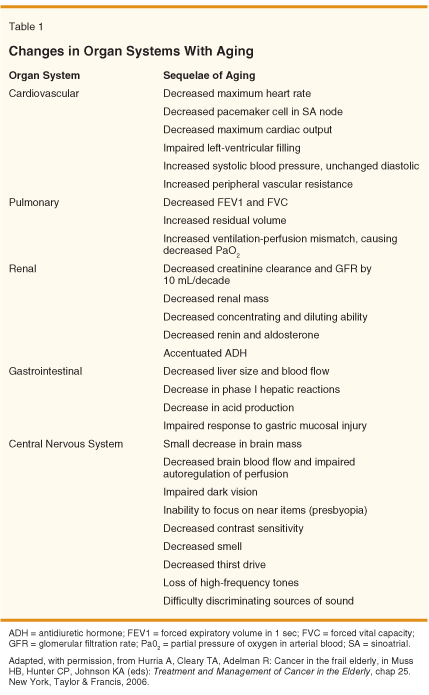
Diminished muscle mass and strength are associated with decreased mobility, decreased ability to perform activities of daily living (ADLs, Table 2), and a higher risk of hospitalization and nursing home admission.[19] Contributing to age-associated sarcopenia are genetics; a reduced production of growth hormone, testosterone, and insulin-like growth factor type 1 (IGF-1); an increase in inflammatory cytokines; increased protein degradation; and decreased protein synthesis.[20] In addition to age-related changes in mobility, other contributors to sarcopenia include lack of exercise and increased oxygen free radical production. Sarcopenia is not necessarily associated with a reduced body mass index-sarcopenic obesity may occur in up to 6 % of the elderly[21] and can carry an even greater risk of adverse outcomes, especially in those who are less active.[22,23]
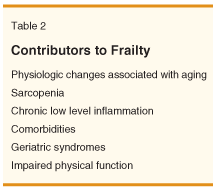
Progressive inflammation, a consistent finding with aging, has also been proposed as a mechanism for the development of frailty. C-reactive protein and interleukin-6 (IL-6) levels increase with age.[24] An increase in IL-6 and D-dimer predict functional decline and mortality in community-dwelling elders over age 70.[24] Individuals among the Cardiovascular Health Study cohort meeting the criteria for frailty had increased levels of C-reactive protein, factor VIII, and D-dimer compared to nonfrail individuals.[25] The association of an increase in inflammatory markers with age and functional decline has led to the possibility of using biomarkers as indicators of frailty.[9]
Comorbidity also contributes to frailty, and in general the more medical problems that exist, the more likely a patient is to be frail.[26] Comorbid conditions that cause functional limitations and are expected to progress, such as cardiovascular disease, pulmonary disease, or diabetes, limit survival and are more likely to contribute to frailty.[27] Elders with comorbidity are at increased risk for treatment-related complications and mortality.[28,29] Satariano and Ragland evaluated the effect of comorbidity on 3-year survival among women with primary breast cancer. Those with three or more comorbid conditions had a 20-fold higher rate of mortality from a cause other than breast cancer and a 4 times higher rate of all-cause mortality compared to women with no comorbid conditions.[27]
Other contributors to frailty are the geriatric syndromes. Geriatric syndromes are considered easily recognized clinical presentations that have multifactorial etiologies and are associated with an increased risk for adverse outcomes.[30,31] They include dementia, polypharmacy, falls, incontinence, pressure ulcers, sensory impairment, and malnutrition.[31] Cognition and dementia are critical issues in cancer management; individuals undergoing therapy need to have the cognitive capacity to take medications correctly and report side effects.[32]
It is difficult to separate impaired physical function and disability from frailty as they are both contributors to and consequences of frailty. Frail individuals often have immobility, gait abnormalities, muscle weakness, minimal exercise tolerance, and poor balance.[7] They may have difficulty performing ADLs and instrumental activities of daily living (IADLs), which are thought to be critical in the ability of elderly individuals to maintain function (Table 2). Tasks for independent living including those for self-care are important for quality of life. Conditions associated with frailty are listed in Table 3.
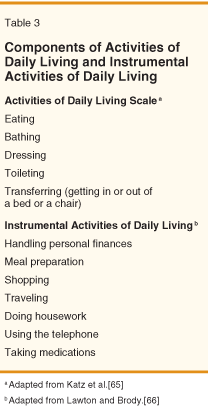
Tools for Geriatric and Frailty Assessment
Ideally, oncologists treating the elderly should be able to differentiate between a high-functioning elder, a patient who is currently functioning but is at risk for treatment complications, and those too frail to receive aggressive therapy. However, correctly identifying individuals who belong to these three groups is difficult. The importance of performance status has long been appreciated in oncology with development of the Karnofsky performance status scale over 50 years ago.[33] Karnofsky and Eastern Cooperative Oncology Group (ECOG)performance status may be insufficient to identify risk, and assessment tools to identify at-risk and frail elders are needed in oncology.
Criteria for defining frailty among the general population have been developed. Clinical criteria for frailty were adapted by the National Institute of Aging and the American Geriatric Society Expert Consensus in 2004.[34] Using data from the Cardiovascular Health Study, a phenotype of frailty was operationalized.[10] Individuals with 3 or more criteria were determined to be frail, and those with 1 to 2 criteria were considered prefrail (Table 4). At 3 years, the mortality rate was 18% for frail patients and 3% for the nonfrail. The prevalence of frailty increased with age and was greater in women than men. Compared to fit older subjects, those who were moderately or severely frail had an eightfold higher risk of institutionalization (relative risk [RR] = 8.6) and a sevenfold increased risk of death (RR = 7.3). Individuals defined as frail had a higher incidence of hospitalization and falls, progressive decline in the ability to complete ADLs, and decreased mobility. Those considered prefrail were at increased risk of becoming frail.
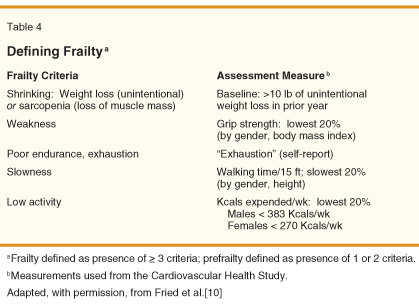
The Comprehensive Geriatric Assessment (CGA) is a multidimensional, often interdisciplinary diagnostic approach used by geriatricians to care for the elderly.[35] It measures several domains including comorbid medical conditions, use of medication, social support, functional status, cognition and nutritional states, and generally includes an assessment of ADLs and IADLs.[8] Once assessments are made, the CGA is interpreted with a multidisciplinary approach, and interventions are implemented. Reviews of CGA have shown benefit in elderly individuals.[8]
A CGA scale for elderly cancer patients has been developed by the Italian Group for Geriatric Oncology.[36,37] Repetto et al evaluated ECOG performance status and CGA in 363 elderly patients with cancer. Of patients felt to have a good performance status, 13% had two or more comorbidities, 9.3% had ADL impairment, and 37% had IADL limitations. Performance status alone missed impairment that was identified with CGA.[37] Balducci and others evaluated a CGA in elderly patients and identified 18% as having dependence in one or more ADLs, 72% with dependence in one or more IADLs, 41% with polypharmacy, and 19% with malnutrition.[35,38]
A limitation of the CGA is the length of time it takes to complete, prompting researchers to develop shorter self-administered comprehensive assessments. The Cancer and Leukemia Group B (CALGB) is currently testing a cancer-specific geriatric assessment that includes self-assessment and health-care–directed components. In a pilot study, it was determined to take less than 30 minutes to complete.[39]
The Vulnerable Elders Survey (VES-13) is a tool developed to identify community-living older adults at risk of functional decline and death.[40] It includes one question for age and 12 items that assess self-reported health. The VES-13 has been pilot-tested as a screening tool in older adults with prostate cancer.[41] Using the CGA as the gold standard, the VES-13 had 72.7% sensitivity and 85.7% specificity for CGA-detected deficits.
Interventions to Prevent or Redcue the Severity of Frailty
Transitions between frailty, prefrailty, and nonfrail states occur.[42] If risk factors for the development of frailty can be identified, interventions to preserve or enhance functional capacity can be instituted concurrently with cancer therapy. The at-risk or prefrail patient is the ideal candidate for preventive interventions to maintain or improve physical function during or after cancer therapy.
Evidence suggests that exercise can minimize several physiologic changes associated with aging.[43] In one study, physically active adults were more likely to survive to age 80 years or more and had half the risk of dying with a disability.[44] Another study showed that even in individuals in home-care programs, active patients were less likely to die than those with no or low-intensity physical activity.[45] This relationship was noted even for patients over age 80.
Resistance training in particular is effective in improving strength and increasing muscle mass in older adults.[46] In a systematic review of 62 randomized clinical trials, Latham identified improvements in muscle strength and gait speed.[48] However, improvement in aerobic capacity and balance was inconsistent. Exercise training appears to be effective in elderly populations considered to be frail, such as those in nursing homes.[43,49] For the very old or frail, scheduled daily activity such as walking or housekeeping can help postpone frailty and prolong independence.[20]
Progression to frailty may also be delayed by managing the chronic conditions and geriatric syndromes identified by CGA. In a pilot evaluation of early breast cancer patients over the age of 70, CGA assessment resulted in 17 interventions per patient and was felt to influence oncologic treatment in 4 of 11 patients.[50] Arnoldi et al evaluated a CGA model in 153 patients over age 70 to help identify those eligible for oncologic treatment or supportive care.[51] The CGA identified 30 borderline and 14 frail individuals. Although therapy choices were not dictated by CGA results, a higher percentage of nonfrail subjects received therapy, and frail subjects were significantly more likely to die in 6 months than nonfrail patients.
In a randomized trial, McCorkle et al evaluated a CGA assessment vs usual postsurgical care in cancer patients undergoing surgery.[52] A home-care intervention was planned based on the comprehensive assessment. Postsurgical cancer patients receiving the specialized CGA-based home-care intervention had improved survival compared to the usual care group. The data available about elderly cancer patients suggest that it is important to identify and consider frailty before finalizing diagnosis and therapy plans.
Treatment of Breast Cancer in the Frail Elderly
Diagnosis and Treatment of the Primary Lesion
The benefits of mammographic screening are questionable in the frail elderly, and such imaging should be avoided for women with an estimated survival of less than 5 years. Annual breast examination should suffice for finding breast cancers serious enough to have an impact on the frail elderly woman's survival and quality of life. Nevertheless, mammography is still likely to be performed in many of these patients and will occasionally detect early nonpalpable breast cancers.
If a suspicious lesion is detected mammographically, the physician is then compelled to evaluate the abnormality, and a biopsy is needed. In general, core biopsy is preferred over fine-needle aspiration since core biopsy is superior in establishing whether the breast lesion represents in situ or invasive carcinoma and can also be used for assessment of estrogen and progesterone receptors. For some frail patients, excision of the breast lesion-especially if it is negative for both estrogen and progesterone receptors-may be the best approach. In most frail patients treated with lumpectomy and whose tumors have clear margins, radiation therapy is not likely to be of any survival benefit and can be omitted. For frail women with hormone receptor–positive lesions, primary endocrine therapy with either tamoxifen or an aromatase inhibitor (AI) should be considered.
A wealth of data exist on the use of tamoxifen as primary therapy in older women with breast cancer, including several randomized trials comparing tamoxifen alone to mastectomy or lumpectomy. Such trials have generally shown no significant difference in survival for tamoxifen-treated patients compared to those receiving surgical intervention. About 75% of women treated with tamoxifen alone have a complete or partial response.
In one trial of 100 frail elderly women with breast cancer, 40% of patients had a complete response (median duration: 47 months) and 22% a partial response (median duration: 26 months). Time to disease progression was about 15 months for the remaining patients.[53] After a median follow-up of about 5 years, only 11% of patients required surgery for local progression. Other trials using tamoxifen alone show similar results. For women with an estimated survival of 5 years, surgery is superior for local control of the primary lesion, but for the frail patient, endocrine therapy alone is likely to provide local control for the duration of the patient's life.
Aromatase inhibitors have been shown to be superior to tamoxifen in randomized trials in the adjuvant, neoadjuvant, and metastatic setting.[54-57] AIs are not associated with an increased risk of endometrial cancer or thromboembolism. Frail elders without hysterectomy are unlikely to have the annual pelvic examinations needed for monitoring tamoxifen therapy, and the lower physical activity levels in frail elders may increase their risk of tamoxifen-related thromboembolism. AIs are associated with a modestly increased risk of fractures compared to tamoxifen, but this risk can be overcome with the use of oral bisphosphonates. For frail patients who progress on initial endocrine therapy, other hormonal agents can be used for disease control. For the frail elder who is not amenable to surgery and who presents with hormone receptor–negative breast cancer, chemotherapy or local radiation therapy might be considered for those with symptoms or rapid tumor growth.
Systemic Adjuvant Therapy
Healthy elders with hormone receptor–positive cancer derive major benefits from tamoxifen therapy, with annual risk reductions in relapse, breast cancer mortality, and new contralateral breast cancer of 30% to 50%.[58,59] The recent meta-analysis conducted by the Early Breast Cancer Trialists' Collaborative Group shows that the majority of breast cancer relapses in hormone receptor–positive patients occurs after 5 years, irrespective of tamoxifen use.
Frail elders with hormone receptor–positive breast cancers are only likely to benefit from adjuvant endocrine therapy with either tamoxifen or AIs if they have an extremely high risk of relapse within a 5-year period. Estimates of the benefits of treatment can be made using the Web-based program Adjuvant! Online (www.adjuvantonline.com). This program factors in the US census–derived mortality data by age, and one can add an estimate of comorbidity to the program to factor in the effect of coexisting illness on treatment benefit. An example of how this can help in treatment selection is shown in Table 5. This example shows that endocrine treatment is likely to be of minimal to no value in improving survival in most frail elders, whose survival would likely be even worse without treatment than that of the patient with poor health used in this example. Moreover, the effectiveness of more intensive chemotherapy (for example, the dose-dense therapy described in this table) when added to endocrine therapy is likely overestimated in this program.
Frail elders with hormone receptor–negative breast cancer and with an expected survival of less than 5 years are not candidates for current adjuvant chemotherapy regimens, even if they have extensive nodal involvement.
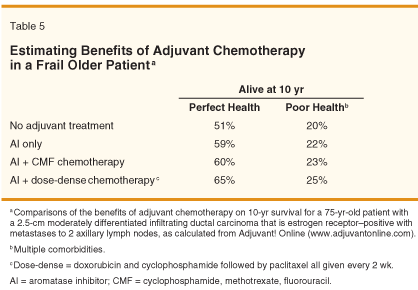
Metastatic Breast Cancer
Metastatic breast cancer is incurable, and the goals of treatment are to control symptoms and disease progression, and improve quality of life. The majority of frail elders with metastatic breast cancer will have hormone receptor–positive tumors, and the mainstay of treatment is endocrine therapy. For patients who have not had prior endocrine therapy, the initial use of an aromatase inhibitor is probably the best choice. Upon disease progression, other endocrine agents should be used, including tamoxifen, other aromatase inhibitors, or fulvestrant (Faslodex).
Megestrol acetate or high-dose estrogens are also appropriate in selected patients with slow progression of metastases who have exhausted other hormonal agents. For the frail elder with hormone receptor–positive early breast cancer who develops metastatic disease while being treated with primary endocrine therapy, a similar strategy should be used. Such a treatment plan is likely to control metastases for the lifetime of the patient.
For patients refractory to endocrine therapy or those with hormone receptor–negative breast cancer, single-agent chemotherapy can be tried. Many single agents are well tolerated and can be started in smaller does to minimize toxicity. These include the oral agent capecitabine (Xeloda), weekly low-dose anthracyclines or pegylated liposomal doxorubicin (Doxil), weekly taxanes, vinorelbine, and gemcitabine (Gemzar). For those with HER2-positive tumors, trastuzumab (Herceptin) alone can be considered and is usually well tolerated.[60] Frail elders treated with chemotherapy need to be closely monitored for toxicity.
For patients with bone metastases, radiation administered to affected areas can be most effective. IV bisphosphonates, which can reduce pain and other skeletal events, should be considered for patients with painful lesions. Radiation should also be considered for treatment of central nervous system (CNS) metastases or other localized metastatic lesions. A major issue in many frail elders with CNS metastases is whether to treat at all, especially those with cognitive disorders. The decision to treat must include a careful discussion of the goals of treatment with the patient, her family, and her other caregivers.
At some point, treatment of metastatic cancer becomes futile and such patients should be referred for palliative and hospice care. Such care is also appropriate for frail elders with metastatic disease who decline therapy. This is likely to occur much sooner in frail elders with metastases than in their healthier counterparts.
Recommendations
Breast cancer has been undertreated in elderly individuals, and elders continue to be underrepresented in clinical trials,[61,62] despite data that older women with breast cancer and younger postmenopausal patients derive similar benefits from treatment.[63,64] However, some elders may be unable to tolerate the toxicity and stress associated with cancer therapy. Frail elders with breast cancer are a challenging group. Geriatric assessment can help identify frail patients and suggest useful interventions. Nevertheless, most frail patients are still likely to have a shortened survival that minimizes the benefits of standard therapies.
The increasing numbers of older adults with a cancer diagnosis demand that oncologists prepare themselves to mange the challenges of the frail older cancer patient. In particular, skills to appropriately target the intensity of interventions, to identify complicating factors, and to prevent toxicity and institute supportive care where appropriate are needed. Balducci has suggested that several questions be considered prior to making treatment decisions[38]: Will the patient die of cancer or with cancer? Will the patient suffer the complications of cancer during his/her lifetime? Is the patient able to tolerate the treatment of cancer? Is palliation appropriate? These questions help frame a treatment approach.
The National Comprehensive Cancer Network (NCCN) has put forth a treatment guideline for senior adult oncology patients. The NCCN guideline includes the Fried criteria for assessing frailty,[10] an example of Comprehensive Geriatric Assessment, and the VES-13 as a screen for impairment. In addition to evaluating the patient, it is important to consider the effects of the patient's illness on family and friends, and to realize that the patient may be independent at the beginning of therapy but become temporarily or permanently dependent over time. A support system is necessary to assess function, monitor side effects, and assist in emergencies.
More research is needed to define frailty, identify its contributors, and develop assessment tools for the older oncology population. It is not yet clear how an abnormal finding on screening for frailty should impact cancer therapy decision-making. Future research evaluating variations in treatment intensity and best supportive care when warranted would be enhanced by a rigorous assessment of frailty and frailty risk. Assessment of frailty needs to be integrated into evaluation of response, toxicity, survival, and quality of life among elderly cancer patients.
Disclosures:
The authors have no significant financial interest or other relationship with the manufacturers of any products or providers of any service mentioned in this article.
References:
1. Yancik R: Population aging and cancer: A cross-national concern. Cancer J 11:437-441, 2005.
2. Yancik R: Cancer burden in the aged: An epidemiologic and demographic overview. Cancer80:1273-1283, 1997.
3. Ries LAG, Melbert D, Krapcho M, et al (eds): SEER Cancer Statistics Review, 1975-2004. Bethesda, MD; National Cancer Insitiute. Based on November 2006 SEER data submission, posted to the SEER website, 2007. Available at http://seer.cancer.gov/csr/1975_2004/. Accessed Nov 11, 2007.
4. National Center for Health Statistics, United States Census Bureau. Vital Statistics of the United States. Hyattsville, MD; National Center for Health Statistics, 2001.
5. Yancik R, Ries LG, Yates JW: Breast cancer in aging women. A population-based study of contrasts in stage, surgery, and survival. Cancer 63:976-981, 1989.
6. Kimmick GG., Hughes KS, Muss HB: Breast cancer in older women, in Harris JR, Lippman ME, Morrow M, et al (eds): Diseases of the Breast, pp 1323-1338. Philadelphia, Lippincott Williams & Wilkins; 2004.
7. Ferrucci L, Guralnik JM, Studenski S, et al: Designing randomized, controlled trials aimed at preventing or delaying functional decline and disability in frail, older persons: A consensus report. J Am Geriatr Soc 52:625-634, 2004.
8. Ferrucci L, Guralnik JM, Cavazzini C, et al: The frailty syndrome: A critical issue in geriatric oncology. Crit Rev Oncol Hematol 46:127-137, 2003.
9. Cohen HJ: In search of the underlying mechanisms of frailty. J Gerontol A Biol Sci Med Sci 55:M706-M708, 2000.
10. Fried LP, Tangen CM, Walston J, et al: Frailty in older adults: Evidence for a phenotype. J Gerontol A Biol Sci Med Sci 56:M146-M156, 2001.
11. Fried LP, Kronmal RA, Newman AB, et al: Risk factors for 5-year mortality in older adults: The Cardiovascular Health Study. JAMA 279:585-592, 1998.
12. Fried LP, Ferrucci L, Darer J, et al: Untangling the concepts of disability, frailty, and comorbidity: Implications for improved targeting and care. J Gerontol A Biol Sci Med Sci 59:255-263, 2004.
13. Balducci L: Geriatric oncology: Challenges for the new century. Eur J Cancer 36:1741-1754, 2000.
14. Fried LP, Walston J: Frailiy and failure to thrive, in Hazzard WR, Blass JP, Ettinger WH, et al (eds): Principles of Geriatric Medicine and Geontology pp 1387-1402. New York, McGraw-Hill, 1999.
15. Rodin MB, Mohile SG: A practical approach to geriatric assessment in oncology. J Clin Oncol 25:1936-1944, 2007.
16. Hurria A, Cleary TA, Adelman RD: Cancer in the frail elderly, in Muss HB, Hunter C, Johnson KA (eds): Treatment and Management of Cancer in the Elderly, pp 539-557. New York, Taylor & Francis, 2006.
17. Muss HB, Woolf S, Berry D, et al: Adjuvant chemotherapy in older and younger women with lymph node-positive breast cancer. JAMA 293:1073-1081, 2005.
18. Muss HB, Berry DA, Cirrincione C, et al: Toxicity of older and younger patients treated with adjuvant chemotherapy for node-positive breast cancer: The Cancer and Leukemia Group B experience. J Clin Oncol 25:3699-3704, 2007.
19. Guralnik JM, Simonsick EM, Ferrucci L, et al: A short physical performance battery assessing lower extremity function: Association with self-reported disability and prediction of mortality and nursing home admission. J Gerontol 49:M85-M94, 1994.
20. Abate M, Diloria A DiRenzo D, et al: Fraility in the elderly: The physical dimension. Europa Medicophysica 42:1-9, 2006.
21. Baumgartner RN, Wayne SJ, Waters DL, et al: Sarcopenic obesity predicts instrumental activities of daily living disability in the elderly. Obes Res 12:1995-2004, 2004.
22. Janssen I: Influence of sarcopenia on the development of physical disability: The Cardiovascular Health Study. J Am Geriatr Soc 54:56-62, 2006.
23. Visser M, Goodpaster BH, Kritchevsky SB, et al: Muscle mass, muscle strength, and muscle fat infiltration as predictors of incident mobility limitations in well-functioning older persons. J Gerontol A Biol Sci Med Sci 60:324-333, 2005.
24. Ferrucci L, Corsi A, Lauretani F, et al: The origins of age-related proinflammatory state. Blood 105:2294-2299, 2005.
25. Walston J, McBurnie MA, Newman A, et al: Frailty and activation of the inflammation and coagulation systems with and without clinical comorbidities: Results from the Cardiovascular Health Study. Arch Intern Med 162:2333-2341, 2002.
26. Mitnitski AB, Song X, Rockwood K: The estimation of relative fitness and frailty in community-dwelling older adults using self-report data. J Gerontol A Biol Sci Med Sci 59:M627-M632, 2004.
27. Satariano WA, Ragland DR: The effect of comorbidity on 3-year survival of women with primary breast cancer. Ann Intern Med 120:104-110, 1994.
28. Satariano WA: Aging, comorbidity, and breast cancer survival: An epidemiologic view. Adv Exp Med Biol 330:1-11, 1993.
29. Bergman L, Dekker G, van Leeuwen FE, et al: The effect of age on treatment choice and survival in elderly breast cancer patients. Cancer 67:2227-2234, 1991.
30. Maas HA, Janssen-Heijnen ML, Olde Rikkert MG, et al: Comprehensive geriatric assessment and its clinical impact in oncology. Eur J Cancer 43:2161-2169, 2007.
31. Inouye SK, Studenski S, Tinetti ME, et al: Geriatric syndromes: Clinical, research, and policy implications of a core geriatric concept. J Am Geriatr Soc 55:780-791, 2007.
32. Hurria A, Lachs MS, Cohen HJ, et al: Geriatric assessment for oncologists: Rationale and future directions. Crit Rev Oncol Hematol 59:211-217, 2006.
33. Karnofsky DA: Determining the extent of the cancer and clinical planning for cure. Cancer 22:730-734, 1968.
34. Walston J, Hadley EC, Ferrucci L, et al: Research agenda for frailty in older adults: Toward a better understanding of physiology and etiology: summary from the American Geriatrics Society/National Institute on Aging Research Conference on Frailty in Older Adults. J Am Geriatr Soc 54:991-1001, 2006.
35. Balducci L: The geriatric cancer patient: Equal benefit from equal treatment. Cancer Control 8:1-25, 2001.
36. Monfardini S, Ferrucci L, Fratino L, et al: Validation of a multidimensional evaluation scale for use in elderly cancer patients. Cancer 77:395-401, 1996.
37. Repetto L, Fratino L, Audisio RA, et al: Comprehensive geriatric assessment adds information to Eastern Cooperative Oncology Group performance status in elderly cancer patients: An Italian Group for Geriatric Oncology Study. J Clin Oncol 20:494-502, 2002.
38. Balducci L, Extermann M: Management of cancer in the older person: A practical approach. Oncologist 5:224-237, 2000.
39. Hurria A, Gupta S, Zauderer M, et al: Developing a cancer-specific geriatric assessment: A feasibility study. Cancer 104:1998-2005, 2005.
40. Saliba D, Elliott M, Rubenstein LZ, et al: The Vulnerable Elders Survey: A tool for identifying vulnerable older people in the community. J Am Geriatr Soc 49:1691-1699, 2001.
41. Mohile SG, Bylow K, Dale W, et al: A pilot study of the vulnerable elders survey-13 compared with the comprehensive geriatric assessment for identifying disability in older patients with prostate cancer who receive androgen ablation. Cancer 109:802-810, 2007.
42. Gill TM, Gahbauer EA, Allore HG, et al: Transitions between frailty states among community-living older persons. Arch Intern Med 166:418-423, 2006.
43. Singh MA: Exercise comes of age: rationale and recommendations for a geriatric exercise prescription. J Gerontol A Biol Sci Med Sci 57:M262-M282, 2002.
44. Leveille SG, Guralnik JM, Ferrucci L, et al: Aging successfully until death in old age: opportunities for increasing active life expectancy. Am J Epidemiol 149:654-664, 1999.
45. Landi F, Cesari M, Onder G, et al: Physical activity and mortality in frail, community-living elderly patients. J Gerontol A Biol Sci Med Sci 59:833-837, 2004.
46. Barry BK, Carson RG: The consequences of resistance training for movement control in older adults. J Gerontol A Biol Sci Med Sci 59:730-754, 2004.
47. Taaffe DR: Sarcopenia-exercise as a treatment strategy. Aust Fam Physician 35:130-134, 2006.
48. Latham NK, Bennett DA, Stretton CM, et al: Systematic review of progressive resistance strength training in older adults. J Gerontol A Biol Sci Med Sci 59:48-61, 2004.
49. Seynnes O, Fiatarone Singh MA, et al: Physiological and functional responses to low-moderate versus high-intensity progressive resistance training in frail elders. J Gerontol A Biol Sci Med Sci 59:503-509, 2004.
50. Extermann M, Meyer J, McGinnis M, et al: A comprehensive geriatric intervention detects multiple problems in older breast cancer patients. Crit Rev Oncol Hematol 49:69-75, 2004.
51. Arnoldi E, Dieli M, Mangia M, et al: Comprehensive geriatric assessment in elderly cancer patients: An experience in an outpatient population. Tumori 93:23-25, 2007, 2007.
52. McCorkle R, Strumpf NE, Nuamah IF, et al: A specialized home care intervention improves survival among older post-surgical cancer patients. J Am Geriatr Soc 48:1707-1713, 2000.
53. Akhtar SS, Allan SG, Rodger A, et al: A 10-year experience of tamoxifen as primary treatment of breast cancer in 100 elderly and frail patients. Eur J Surg Oncol 17:30-35, 1991.
54. Smith I, Dowsett M, on behalf of the IMPACT Trialists: Comparison of anastrozole versus tamoxifen alone and in combination as neoadjuvant treatment of ER+ operable breast cancer in postmenopausal women: The IMPACT Trial. Presented at the Annual San Antonio Breast Cancer Symposium; San Antonio Tex; 2004.
55. Smith IE, Dowsett M: Aromatase inhibitors in breast cancer. N Engl J Med 348:2431-2442, 2003.
56. Smith IE, Dowsett M, Ebbs SR, et al: Neoadjuvant treatment of postmenopausal breast cancer with anastrozole, tamoxifen, or both in combination: The Immediate Preoperative Anastrozole, Tamoxifen, or Combined With Tamoxifen (IMPACT) multicenter double-blind randomized trial. J Clin Oncol 23:5108-5116, 2005.
57. Ellis MJ, Coop A, Singh B, et al: Letrozole is more effective neoadjuvant endocrine therapy than tamoxifen for ErbB-1- and/or ErbB-2-positive, estrogen receptor- positive primary breast cancer: Evidence from a phase III randomized trial. J Clin Oncol 19:3808-3816, 2001.
58. Group: Effects of chemotherapy and hormonal therapy for early breast cancer on recurrence and 15-year survival: An overview of the randomised trials. Lancet 365:1687-1717, 2005.
59. Witherby SM, Muss HB: Special issues related to breast cancer adjuvant therapy in older women. Breast 14:600-611, 2005.
60. Vogel CL, Cobleigh MA, Tripathy D, et al: Efficacy and safety of trastuzumab as a single agent in first-line treatment of HER2-overexpressing metastatic breast cancer. J Clin Oncol 20:719-726, 2002.
61. Hutchins LF, Unger JM, Crowley JJ, et al: Underrepresentation of patients 65 years of age or older in cancer- treatment trials. N Engl J Med 341:2061-2067, 1999.
62. Sateren WB, Trimble EL, Abrams J, et al: How sociodemographics, presence of oncology specialists, and hospital cancer programs affect accrual to cancer treatment trials. J Clin Oncol 20:2109-2117, 2002.
63. Muss HB, Woolf S, Berry D, et al: Adjuvant chemotherapy in older and younger women with lymph node-positive breast cancer. JAMA 293:1073-1081, 2005.
64. Christman K, Muss HB, Case LD, et al: Chemotherapy of metastatic breast cancer in the elderly. The Piedmont Oncology Association experience JAMA 268:57-62, 1992.
65. Katz S, Ford AB, Moskowitz RW, et al: Studies of illness in the aged. The index of ADL: A standardized measure of biological and psychosocial function. JAMA 185:914-919, 1963.
66. Lawton MP, Brody EM: Assessment of older people: Self-maintaining and instrumental activities of daily living. Gerontologist 9:179-186, 1969.